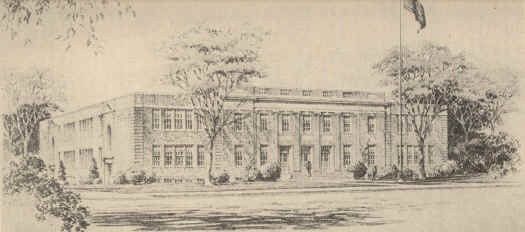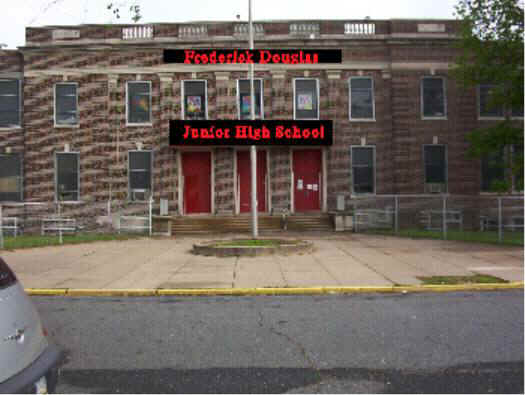| Faculty: |
Some Teachers:
c. 1941: - 6
Ms. Anderson - English
Ms. Pinder - English
Mr. Duffy - science
Ms. DeShields - social studies
Ms. Smith - handwriting
Mr. London Jones - health and physical education
Mr. Swigget - mathematics
Mr. Beverly Y. Blow - Latin (and Assistant Principal)
Ada P. Kilson Griffin (retired before c. 1954) - Mathematics (Mrs.
Griffin's husband, Levi, was a
Chester patrolman.)
From "The Helm"
(Frederick Douglass' yearbook), 1966: - 3: (Click
here for pictures of these faculty & staff members)
Anderson, Emma D. - English
Baker, Lucy M. - Social Studies
Bright, Beatrice K. - Reading
Brown, Gwendolyn - Librarian
Burke, Annette - Practical Arts
Carey, Druretta B. - Science
Carpenter, Earl H. - Industrial Arts
Carroll, Frank W. - Science
Cheeks, Addie G. - Social Studies
Collins, McClure R. - Special Education
Danna, Samuel - Industrial Arts
DeShields, Clara V. - Social Studies
Dockens, Katharine - Geography
Frye, Gary H. - Band
Hill, Leon J. - Foreign Languages
Holmes, Leo S. - Mathematics
Hunt, Kenneth W. - Industrial Arts
Johnson, Catherine - Practical Arts
Johnson, Louise B. - Music
Jones, London B. - Physical Education
Lewis, Roberta G. - English
Logan, Hermione - Practical Arts
Lucas, Toney - Science
Maggitti, Phillip - English
Perry, Theron - Science, Math
Richardson, Sara V. - Mathematics
Slater, Jessie - Physical Education
Mahoney, William - Geography
Sweeney, Charles - English
Swiggett, Samuel T. - Mathematics
Tucker, Elizabeth - Business Education
West, Joseph - Mathematics
Johnson, Eugene - Boys' Guidance
Counselor
Powell, Jessie - Girls' Guidance Counselor
Holmes, Leo S. - Home School Visitor
(formerly a Mathetmatics
teacher; newly elected City Councilman c. 1966) - [Biographical
sketch]
c. 1968-1971: - 2
Mrs. Lewis (English)
Mrs. Dockerty (?geography)
Mr. Melton (French)
Ms Baker (Social Studies)
Mrs. Deshields (History)
Louise B. Johnson (music)
Andrew Turner (noted artist) taught art at Douglas for a few years, during the late 60's-early 70's.
Mr. Johnson (English) - 4
Ms. Louise Barnes (Music) - 4
Harold
Tilghman Smith (1950-1960) - 5 |
| Recollections: |
August
31, 2006
"I Remember Fondly, Douglass Jr. High...
There are good memories and bad memories about time spent at Douglass Jr. High. People like Mrs. Deshields and Mrs. Barnes are definitely in the good memory file.
I have yet to see a school teach like Mrs. Deshields. Social Studies class often became a history lesson, as we learned about everyone from Langston Hughes to Sojourner Truth. Imagine! Back in the late sixties, being a black child in a jr. high and learning about Langston Hughes! Harriet Tubman!! It changed my view about so many things.
And for long as I live, anytime I hear the Negro Anthem, "Lift Every Voice and Sing" I'll always see Mrs. Barnes. The woman was no nonsense, making no bones about what she expected to hear and we gave it to her!
There were others, of course, the ones you could tell didn't really care for you or the way you combed your hair, the color of your skin - the way some of us left the shine of our legs on the chairs we sat on. But we also ran into the ones who really wanted us to succeed. Does anyone remember the really, really pretty woman who was the secretary of the school? She was the "Julia" of Douglass. I know someone out here knows who I'm talking about. If anyone remembers her name, pass it on."
Johanna
Blanding-Koskinen, HCV/HIV/STD Health Counselor
Executive Director
Hepatitis C Multicultural Outreach
Kansas City, MO
August
2004:
"Growing up in Chester was like growing up in the Deep South. During the slavery period Chester was labeled “up south” because of its proximity to slave states like Delaware and Maryland. Despite the presence of a historically liberal Quaker population, the Quakers were overwhelmed by southern traditions of segregation. So, we had segregated schools (until the 11th grade), and segregated everything else, until black and white children passed mate-choice age.
After graduating from Booker T. Washington Elementary School in 1941, I was enrolled in Douglass Jr. High School. The principal was William K. Valentine. Beverly Y. Blow served as the assistant principal and taught Latin. Mr. Blow appeared to have had a classic education because of his erudite manner but showed very little respect for us as students.
Ms. Anderson and Ms. Pinder were English teachers. Mr. Duffy, taught science, Ms. DeShields, taught social studies, Ms. Smith, was our handwriting teacher and London Jones taught health and physical education. Mr. Jones was one of the few staff members who demonstrated a respect for black students. Mr. Blow, Mr. Swigget, who taught mathematics, appeared to care very little about us.
Mr. Jones shaped the character of many students because of his strong positive caring and a compelling influence. He was intimately involved in community activities (mostly in West Chester), that contributed to the knowledge that he brought to our classroom discussions. For example, because of his participation in West Chester and Philadelphia Summer Stock Theater, he had friends and colleagues among notables like Dooley Wilson (the singer/piano player in “Casablanca” the movie w/Bogart). Such relationships expanded his intimate awareness of a world beyond Chester.
The faculty was not aware that some students were aware of what was going on when our principal, Mr. Valentine, entered each teacher’s room on payday and gave them a small brown envelop with cash, from which they handed him a part of their salary for the local political bosses. And, when black adults (and probably whites also), went to cast their vote for the U.S. President and congressional candidates, someone at the polling center walked into the booth with them to make sure that they voted republican. Those who resisted lost their jobs. Sometimes, entire families were black listed.
Students remained in Douglas until the 10th grade. This arrangement meant that black students arrived at
Chester High in the 11th grade. When I arrived at Chester High in 1943, white students “owned” the high school because they had arrived in the 9th grade. And, since all “academic majors” had to make choices in the 9th grade, arriving black students were too late for majors other than general and secretarial education.
I tried to make friends with white students. One day a white teacher saw me talking to a white girl whose last name was Smedley. The teachers quickly changed her schedule, and the next time I saw her she acted strange. That was the end of that little episode.
The course in which I had the most fun was chemistry. The school hired a local pharmacist to teach this chemistry course to black students. The pharmacist lectured for about 10 minutes and left the room in a rush (went to his drug store?), and returned 10 minutes before the end of class. During his absence, I teamed with a black student, Inez Brown. I conducted our experiment and she wrote it up for us; then we turned-in our separate assignments. The teacher who demonstrated the greatest interest in me was Ms Watson, an English teacher. Most other teachers were disdainful. My program at Chester High was extremely modest. Except for a class in public speaking, I learned very little from high school teachers, but I read a lot on my own.
Every morning the entire school met in the auditorium; primarily for announcements, but occasionally the principal would give brief lectures on current issues. One morning Mr. Agan, the principal asked the audience “Has anyone ever heard of the Marshall Plan?” I had just read about it in a magazine at home. My mother was a learned woman, and always had reading material around our home. I was the only one to raise a hand in this audience of 300+ white students and about 18 blacks. I could see the disappointment on the principal’s face as he recognized a single black hand. He abruptly adjourned the session as if he had not asked the question. I was not particularly bothered by his rejection because it was a common experience at Chester High.
I graduated from Chester High School in 1945 and enrolled, practically self-taught, at New York University. I was amazed at how much my classmates at NYU already knew and I worked hard to keep up. I graduated from NYU four years later and started teaching in New York City public schools. By 1955 I had worked in various programs for children in and out of schools and had become known in professional circles.
In the 1960s, I was on the planning committees for Project Head Start and became the program’s coordinator for the Northeast Region (NY, NJ, and the New England States). Since that time I have earned masters and doctorate degrees from the University of Massachusetts-Amherst, and The University of Wisconsin-Madison. I have been a professor at Ohio University, Syracuse University, and Bank Street College in New York City.
At present I am a professor of curriculum and instruction at The University of West Georgia in Carrollton. My most recent books are on Amazon.com and include, Real Learning: A Bridge to Cognitive Neuroscience; Cognitive Styles and Classroom Learning; The Imagination of Early Childhood; and Historical Perspectives on the Education of Black Children."
-
Dr. Harry Morgan, hmorgan AT westga DOT edu and would enjoy hearing from you and sharing our experiences at Booker T., Douglass, and Chester High.
[Editor's note: Ms. Patricia
Lewis-West, currently working on her dissertation on the subject of
segregation in Chester's schools, reports that many black individuals who
she has interviewed have similar responses to those of Dr. Morgan.]
"Only one word comes to mind when I recall my Douglass Jr. High School days -
Excellence! To this day I both appreciate and can recite the Gettysburg Address and
preamble to the U.S. Constitution because Ms. DeShields, my social studies teacher, required that her students
become intimately familiar with America's most famous events and founding documents. If I
write well today, it is because of a foundation in grammar, punctuation, and
sentence structure laid by Mr. Johnson, my English teacher, and subsequently
refined by one of my high school English teachers.
And who can forget Ms. Louise Barnes, Douglass' grand music teacher? Ms.Barnes moved about her music room
with the flair of The Reverend Clayton Powell, Jr. as he swished his robe up and down the center aisle of
Abyssinian Baptist Church in NYC - slowly, deliberatively, authoritatively,
and proudly. With a stern look alone she could turn a noisy classroom into a
haunting rendition of "King Jesus is A Listening." We saw Ms. Barnes as a
Maestro. We particularly looked forward to her spring concerts, which offered budding pianists a rare opportunity
to perform ensembles.
Additionally, Douglass had a way of promoting the talented tenth. Although
we were all pushed and pulled toward mastery of the curriculum, Douglass, in
my opinion, took great pride in recognizing the brightest and the best, who
at that time included James Biggins, Oscar Moore, Audrey Maloney, Yvonne
Outerbridge, and Selena Coker.
- Mary Carter-Williams,
Ph.D. |


